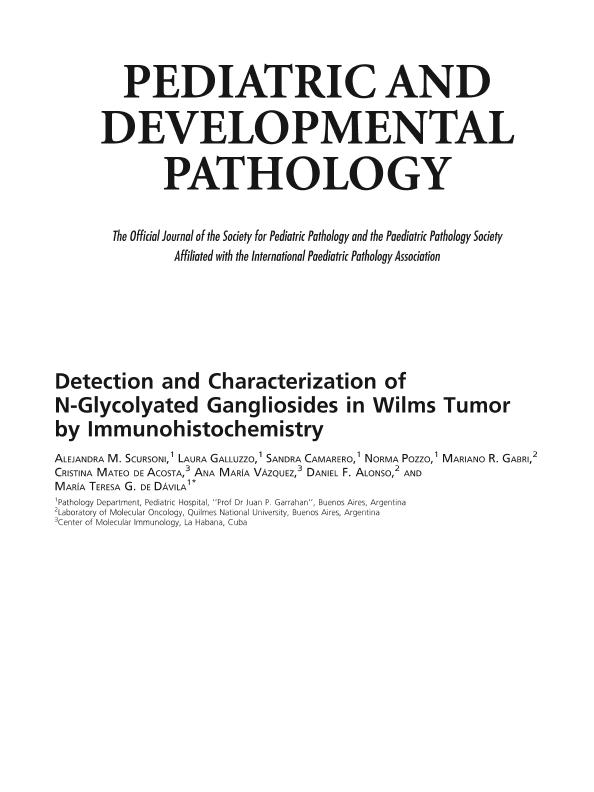Artículo
Detection and characterization of N-glycolyated gangliosides in Wilms tumor by immunohistochemistry
Scursoni, Alejandra M.; Galluzzo, Laura; Camarero, Sandra; Pozzo, Norma; Gabri, Mariano Rolando ; De Acosta, Cristina Mateo; Vázquez, Ana María; Alonso, Daniel Fernando
; De Acosta, Cristina Mateo; Vázquez, Ana María; Alonso, Daniel Fernando ; De Davila, María Teresa G.
; De Davila, María Teresa G.
 ; De Acosta, Cristina Mateo; Vázquez, Ana María; Alonso, Daniel Fernando
; De Acosta, Cristina Mateo; Vázquez, Ana María; Alonso, Daniel Fernando ; De Davila, María Teresa G.
; De Davila, María Teresa G.
Fecha de publicación:
01/2010
Editorial:
Alliance Communications Group Division Allen Press
Revista:
Pediatric And Developmental Pathology
ISSN:
1093-5266
Idioma:
Inglés
Tipo de recurso:
Artículo publicado
Clasificación temática:
Resumen
Gangliosides are glycolipids present on the cell surface. The N-glycolylated ganglioside NeuGc-GM3 has been described in some neoplasms, such as breast carcinoma and melanoma, but is usually not detected in normal human cells. Our aim was to evaluate the presence of NeuGc-GM3 in Wilms tumor by immunohistochemistry. Postchemotherapy tumors were grouped into different histologic subtypes considering the main preserved component. Formalin-fixed, paraffin-embedded tumor samples were cut into 5-mm sections. The monoclonal antibody 14F7, a mouse IgG1 that specifically recognizes NeuGc-GM3, and a peroxidase-labeled polymer conjugated to secondary antibodies were used. Sections from breast carcinoma were employed as positive controls. Presence of NeuGc-GM3 was evident in 22 of 25 (88%) cases. The staining was stronger in the epithelial component, with a membrane pattern and cytoplasmic diffusion. The stromal component expressed cytoplasmic NeuGc-GM3 in cells with rhabdomyoblastic differentiation. Tubules of adjacent renal tissue were also positive, but no expression of NeuGc-GM3 was detected in nontumoral fetal kidney. Until now, the expression of N-glycolylated gangliosides in pediatric solid tumors has not been investigated. The present study evidenced the expression of NeuGc-GM3 in a high proportion of Wilms tumors, suggesting its potential utility as a specific target of immunotherapy.
Archivos asociados
Licencia
Identificadores
Colecciones
Articulos(SEDE CENTRAL)
Articulos de SEDE CENTRAL
Articulos de SEDE CENTRAL
Citación
Scursoni, Alejandra M.; Galluzzo, Laura; Camarero, Sandra; Pozzo, Norma; Gabri, Mariano Rolando; et al.; Detection and characterization of N-glycolyated gangliosides in Wilms tumor by immunohistochemistry; Alliance Communications Group Division Allen Press; Pediatric And Developmental Pathology; 13; 1; 1-2010; 18-23
Compartir
Altmétricas



